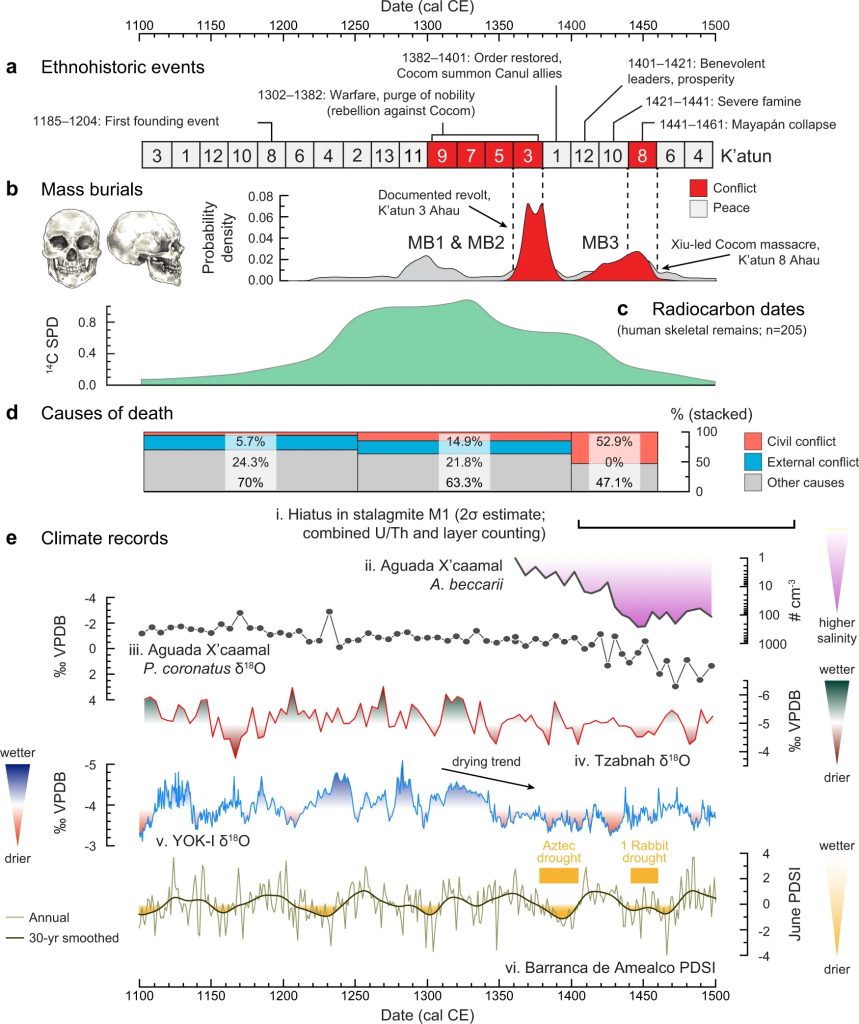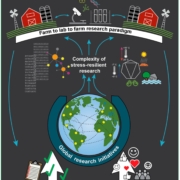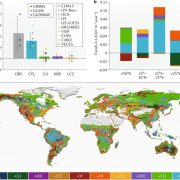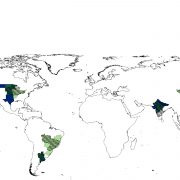Drought-induced civil conflict among the ancient Maya (Nature Comms)
 The observation that “Those who cannot remember the past are condemned to repeat it,” (attributed to philosopher George Santayana) is quite relevant for our efforts to comprehend the impacts of climate change. As we observe temperature and rainfall records being broken with increasing frequency, it remains difficult to know where things are headed, but at the same time it’s important to be aware of where things could go. Without doubt, climate change can lead to social instability, and we can look to the past to see examples of this, as illustrated in a new article by Kennett et al. that draws on an interesting blend of history and science. Specifically, they looked the collapse of the Postclassic Maya capital of Mayapan (1200–1450) on the Yucatán Peninsula (Mexico). This in-depth study pinpoints the influence of prolonged drought as a driver of social conflict, lending weight to the current drive to address climate instability for future social stability. One of the most interesting parts of reading this paper for me, as a non-expert, is the variety of data that these researchers used to draw this conclusion. How does one estimate population? Radiocarbon dating of skeletons: the number skeletons of a certain age reflects the size of the population. How to measure conflict? A high incidence of human remains with “embedded arrowheads, stabbing wounds or blunt force trauma to the skull.” How to measure drought? Obviously tree rings can be used, but another interesting method applied here is to measure the rate of growth of stalagmites (more water = faster stalagmite growth rate). It’s a fascinating multidisciplinary research paper, which you can also read about here https://phys.org/news/2022-07-climate-civil-unrest-ancient-maya.html and here https://phys.org/news/2022-07-climate-conflict-collapse-drought-destabilized.html. (Summary by Mary Williams @PlantTeaching) Nature Comms 10.1038/s41467-022-31522-x.
The observation that “Those who cannot remember the past are condemned to repeat it,” (attributed to philosopher George Santayana) is quite relevant for our efforts to comprehend the impacts of climate change. As we observe temperature and rainfall records being broken with increasing frequency, it remains difficult to know where things are headed, but at the same time it’s important to be aware of where things could go. Without doubt, climate change can lead to social instability, and we can look to the past to see examples of this, as illustrated in a new article by Kennett et al. that draws on an interesting blend of history and science. Specifically, they looked the collapse of the Postclassic Maya capital of Mayapan (1200–1450) on the Yucatán Peninsula (Mexico). This in-depth study pinpoints the influence of prolonged drought as a driver of social conflict, lending weight to the current drive to address climate instability for future social stability. One of the most interesting parts of reading this paper for me, as a non-expert, is the variety of data that these researchers used to draw this conclusion. How does one estimate population? Radiocarbon dating of skeletons: the number skeletons of a certain age reflects the size of the population. How to measure conflict? A high incidence of human remains with “embedded arrowheads, stabbing wounds or blunt force trauma to the skull.” How to measure drought? Obviously tree rings can be used, but another interesting method applied here is to measure the rate of growth of stalagmites (more water = faster stalagmite growth rate). It’s a fascinating multidisciplinary research paper, which you can also read about here https://phys.org/news/2022-07-climate-civil-unrest-ancient-maya.html and here https://phys.org/news/2022-07-climate-conflict-collapse-drought-destabilized.html. (Summary by Mary Williams @PlantTeaching) Nature Comms 10.1038/s41467-022-31522-x.









